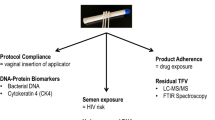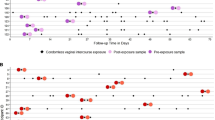Abstract
We assessed the feasibility of a breath test to detect women’s single or concurrent use of vaginal products by adding ester taggants to vaginal gel and condom lubricant. Healthy non-pregnant women were enrolled into a two-day cohort (N = 13) and a single-day cohort (N = 12) in San Francisco. Within each cohort, women were randomized (5:1) to tagged or untagged products, and inserted in a clinical setting: 4 mL of tenofovir placebo gel (ten tagged with 15 mg 2-pentyl acetate; three untagged), and an artificial phallus with a lubricated condom (11 tagged with 15 mg 2-butyl acetate; two untagged), on two separate days (two-day cohort) or concurrently (single-day cohort). Using a portable mini-gas chromatograph, the presence/absence of taggants was determined in breath specimens collected prior to, and at timed intervals following product exposure. Demographic, clinical and product use experience data were collected by structured interview. All participants completed all visits and inserted their assigned products. At 5 min post-insertion, the breath test was 100 % accurate in identifying insertion of the tagged (or untagged) gel and/or condom. The half-life in breath of the two esters tested was <1 h with large variability between individuals, taggants and cohorts. Overall, among those receiving tagged product, six mild and two moderate product-related AEs were reported. All were transient and resolved spontaneously. Additional sensations included taste in mouth (N = 4) and scent (N = 5). The tagged products were well tolerated. This breath test has the potential to accurately and objectively monitor adherence to vaginal gel and condom used separately or concurrently.
Resumen
Se evaluó la viabilidad de una prueba de respiración para detectar, solo o concurrente, uso de los productos vaginales por mediante de las mujeres, añadiendo etiquetados éster al gel vaginal y lubricante de condón. Mujeres saludables, no embarazadas, se inscribieron en una cohorte de dos días (N = 13) y una cohorte de un solo día (N = 12) en San Francisco. Dentro de cada cohorte, mujeres fueron aleatorizadas (5:1) a productos, con o sin etiquetas, que fueron insertados dentro de un entorno clínico: 4 ml del gel placebo tenofovir (10 etiquetado con 15 mg de acetato de 2-pentilo; 3 sin etiqueta), y un falo artificial con un condón lubricado (11 etiquetado con 15 mg de 2-acetato de butilo; 2 no etiquetado), en dos días separados (cohorte de dos días), o concurrentemente (cohorte de un solo día). Usando un mini-cromatógrafo de gases portátil, la presencia / ausencia de etiquetados se determinaron en muestras de aliento recogidas antes de y a intervalos de tiempo, después de la exposición del producto. Datos demográficos, clínicos y de la experiencia sobre el uso del producto se recogieron mediante entrevista estructurada. Todos los participantes completaron todas las visitas y insertaron sus productos asignados. A los 5 minutos después de inserción, la prueba de alcoholemia fue 100% preciso en la identificación de la inserción, con o sin etiqueta, del gel y / o condón. El tiempo que tardo para la mitad de los ésters desglosar y ser eliminados del cuerpo por medio del aliento, de los dos ésteres que fueron usados para la prueba, fue <1 hora con una gran variabilidad entre los individuos, indicadores y cohortes. En general, entre los productos relacionados, etiquetados y recibidos, fueron reportados seis eventos adversos leve y dos moderados. Todos fueron transitorios y se resolvieron espontáneamente. Sensaciones adicionales incluyeron sabor en la boca (n = 4) y aroma (n = 5). Los productos etiquetados fueron bien tolerados. Esta respiración de ensayo es capaz de controlar con precisión y objetivamente la adherencia al gel vaginal y condón usado por separado o concurrentemente.



Similar content being viewed by others
Notes
An additional participant was enrolled into the two-day cohort because of a malfunction of the breath-detection machine (mGC mini Gas Chromatographer) at one of the first 12 participant-visits. Therefore, a 13th participant was enrolled to ensure 12 evaluable sets of data.
References
Weiss HA, Wasserheit JN, Barnabas RV, et al. Persisting with prevention: the importance of adherence for HIV prevention. Emerg Themes Epidemiol. 2008;5(8):1–7.
Mâsse BR, Boily MC, Dimitrov D, Desai K. Efficacy dilution in randomized placebo-controlled vaginal microbicide trials. Emerg Themes Epidemiol. 2009;6:5. doi:10.1186/1742-7622-6-5.
Kashuba ADM, Patterson KB, Dumond JB, Cohen MS. Pre-exposure prophylaxis for HIV prevention: how to predict success. Lancet. 2011;379:2409–11.
van der Straten A, Van Damme L, Haberer JE, Bangsberg DR. Unraveling the divergent results of PrEP Trials for HIV Prevention. AIDS. 2012;26(7):F13–9.
Amico KR, Liu A, McMahan V et al. Adherence indicators and pre-exposure prophylaxis (PrEP) drug levels in the iPrEx study. 18th Conference on retroviruses and opportunistic infections, Boston, Massachusetts. 2011.
Karim SS, Kashuba AD, Werner L, Karim QA. Drug concentrations after topical and oral antiretroviral pre-exposure prophylaxis: implications for HIV prevention in women. Lancet. 2011;378(9787):279–81.
Van Damme L, Corneli A, Ahmed K et al. The FEM-PrEP trial of emtricitabine/tenofovir disoproxil fumarate (Truvada) among African women. The 19th conference on retrovirus and opportunistic infections. 5–8 March 2012, Seattle, Washington. 2012.
Donnell D, Baeten J, Hendrix C et al. Tenofovir disoproxil fumarate drug levels indicate PrEP use is strongly correlated with HIV-1 protective effects: Kenya and Uganda. 19th Conference on retroviruses and opportunistic infections. 5–8 March 2012, Seattle, WA, USA.
Liu A, Huang Y, Defechereux P et al. Hair as a biological marker of daily oral pre-exposure prophylaxis (PrEP) adherence and tenofovir/emtricitabine (TFV/FTC) exposure in the Global iPrEx Study. 6th International AIDS Society conference on HIV pathogenesis, treatment, and prevention, Rome, Italy. 2011.
Hendrix C, Minnis A, Guddera V et al. MTN-001: A phase 2 cross-over study of daily oral and vaginal TFV in healthy, sexually active women results in significantly different product acceptability and vaginal tissue drug concentrations. 18th Conference on retroviruses and opportunistic infections, Boston, MA. 2011.
Adudans MK, Gitome SW, Njoroge BN, Isaacs M, Bukusi EA. Daily monitored adherence (DMA): optimizing adherence in a vaginal microbicide study in Kisumu, Kenya. 6th International AIDS Society, Rome, Italy. 2011.
Haberer J, Psaros C, Baeten J et al. High adherence to oral PrEP is associated with lack of infections in an ancillary study of objective adherence monitoring and counseling among HIV discordant couples in Partners PrEP Study. 19th Conference on retroviruses and opportunistic infections, 5–8 March, Seattle, WA, USA. 2012.
Katzen LL, Fernández-Romero JA, Sarna A, et al. Validation of a dye stain assay for vaginally inserted hydroxyethylcellulose-filled microbicide applicators. Sex Transm Dis. 2011;38(11):1050.
Moench TR, O’Hanlon DE, Cone RA. Evaluation of microbicide gel adherence monitoring methods. Sex Transm Dis. 2012;39(5):335–40.
Gengiah TN, et al. The CAPRISA 004 ‘Wisebag’: Enhancing adherence measurement in microbicide trials. Microbicides 2010 conference, Pittsburgh, USA. 2010.
Haberer J, Kahane J, Kigozi I, et al. Real-time adherence monitoring for HIV antiretroviral therapy. AIDS Behav. 2010;14(6):1340–6.
Morey TE, Booth MM, Prather RA, et al. Measurement of ethanol in gaseous breath using a miniature gas chromatograph. J Anal Toxicol. 2011;35(3):134–42.
Morey T, Booth M, Wasdo S et al. Oral adherence monitoring using a breath test to supplement highly active antiretroviral therapy. AIDS Behav. 2012. doi:10.1007/s10461-012-0318-7.
Morey TE, Wasdo S, Wishin J et al. Feasibility of a breath test for monitoring adherence to vaginal administration of antiretroviral microbicide gels. J Clin Pharm. 2012. doi:10.1177/0091270011434157.
Karim QA, Karim SSA, Frohlich JA, et al. Effectiveness and safety of tenofovir Gel, an antiretroviral microbicide, for the prevention of HIV infection in women. Science. 2010;329:1168–74.
Tien D, Schnaare RL, Kang F, et al. In vitro and in vivo characterization of a potential universal placebo designed for use in vaginal microbicide clinical trials. AIDS Res Hum Retroviruses. 2005;21(10):845–53.
Auvert B, Taljaard D, Lagarde E, et al. Randomized, controlled intervention trial of male circumcision for reduction of HIV infection risk: the ANRS 1265 Trial. PLoS Med. 2005;2(11):e298.
Bailey RC, Moses S, Parker CB, et al. Male circumcision for HIV prevention in young men in Kisumu, Kenya: a randomised controlled trial. Lancet. 2007;369(9562):643–56.
Gray RH, Kigozi G, Serwadda D, et al. Male circumcision for HIV prevention in men in Rakai, Uganda: a randomised trial. Lancet. 2007;369(9562):657–66.
van der Straten A, Cheng H, Moore J, et al. The use of the diaphragm instead of condoms in a phase III diaphragm trial. AIDS Behav. 2009;13(3):564–72.
Acknowledgments
We would like to acknowledge the women who participated in this study, the study team in San Francisco, specifically Katharine Rivett, and Brian John Davis at the Drug Product Service Laboratory, UCSF. We appreciate the review of earlier versions of the manuscript by Dr. Sue Napierala Mavedzenge and Dr. Jill Schwartz and the editorial help from Andrea Hanson Switzky. We extend our special thanks to Daniel Zaccaro for statistical advice. This work was sponsored by CONRAD and the Joachim S. Gravenstein, M.D. Professorship in Anesthesiology.
Conflict of interest
This work was also supported by Xhale, Inc. (Gainesville, FL, USA), and the University of Florida, Department of Anesthesiology (Gainesville, FL, USA). Dr. Dennis is an employee of Xhale, Inc., the company that sponsored the study. Dr. Morey is a consultant for Xhale, Inc. Drs. Dennis and Morey also own equity in Xhale, Inc. In addition, the University of Florida owns equity in Xhale, Inc. If the device is sold commercially, then the authors listed above and the University of Florida could benefit financially. For the remaining authors and institutions, no conflict is declared.
Author information
Authors and Affiliations
Corresponding author
Rights and permissions
About this article
Cite this article
van der Straten, A., Cheng, H., Wasdo, S. et al. A Novel Breath Test to Directly Measure Use of Vaginal Gel and Condoms. AIDS Behav 17, 2211–2221 (2013). https://doi.org/10.1007/s10461-012-0390-z
Published:
Issue Date:
DOI: https://doi.org/10.1007/s10461-012-0390-z




